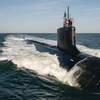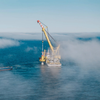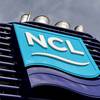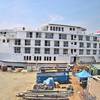Around 360 cruise vessels are operating on the ocean today, transporting thousands of passengers to both new and established locations across the world. The Cruise Boom relishing the industry in recent years has driven growth and advancement with 93 new vessels now under construction showcasing the latest technology available today. Now, the rising popularity of remote and adventurous routes such as the Polar Regions and UNESCO heritage sights has raised concerns about the impacts on marine environments and coastlines. The stakeholders continue to wait for environmental legislation to be set that will determine the green strategies adopted by different operators. Here, we take a brief look at some of the most promising technology available to the cruise industry today.
By Kira Coley
With the push to reduce local impacts from increased traffic and vessel emissions, dozens of potential solutions are being developed including alternative fuels. But, new fuels often require expensive changes to on-board systems and machinery. Furthermore, considerations need to be made around local and global availability, production techniques, and safety concerns.
The holy grail for the shipping industry would be an easily accessible fuel, that can be introduced without significant increase in costs or modifications to facilities onboard the cruise vessel. With no such fuel in sight, the industry looks to develop alternative options available today or in the foreseeable future such as liquefied natural gas (LNG) and biofuels.
Alternative Fuels
Liquefied Natural Gas (LNG) is a clear, odorless, and non-toxic liquid, formed when natural gas cooled to -162C (-260F). It is considered the world’s cleanest-burning fossil fuel today and as such, LNG has received the largest share of attention in forms of investment and development since the trade first began in 1960’s.
“In the past, many engineers have been tasked to design the aerodynamics of the funnel on a cruise vessel so that the particles that leave the stack do not fall onto the deck and unsuspecting passengers. LNG would solve this problem instantly. Beyond the fact it is more environmentally friendly, it is also a fuel type that is becoming more available, and it simply has some practical benefits for the cruise industry which makes it very attractive. Regarding the maritime energy transition, LNG fuel is something we think will be accelerated both in the cruise industry and in general,” said Kjartan Ross, MAN Diesel & Turbo and chairman of Green Ship of the Future.
In 2000, the first LNG-powered vessel was launched and today, there are around 75 LNG-powered ships in operation and another 80 under construction. The growth in LNG-powered ships is expected to accelerate further over the next decade due to the recent Tier III NOx emission standards in North America and forthcoming 0.5% sulfur limits in European waters from 2020.
The world’s largest cruise brand, Carnival Corporation, is expanding its LNG capabilities to supply LNG. At a ceremony in Hamburg in September 2017, Carnival officially marked the start of construction for the first seven next-generation cruise ships that will be fully-powered by LNG. By the end of 2018, they will be the first cruise company to use LNG on the open sea and in port.
While LNG has stolen the spotlight for alternative fuels, there are many other options that show great potential as a substitute for oil in dual-fuel engines. Biofuels and methanol are of particular interest because they also offer significant reductions in emissions of NOx and particulate matter (PM).
Ross said, "An increasing number of companies are specializing in the production of biofuels from sustainable sources. It's quite interesting because this is a fuel solution that you can apply to any vessel, but the challenges are within costs as it is significantly more expensive - around 70-80% - compared to standard fuel prices. And of course, this is an important consideration for many ship owners. But as with all innovation and new techniques, at some point suppliers will find a way to deliver the product at reduced costs. The question is which alternative fuel will get there first? It is a race where Fuel availability and pricing will ultimately decision what solution gets adopted widely.”
As well as the price of the fuel itself, the cost of building or retrofitting dual fuel ships, the size of fuel tanks, and concerns about safety, are also factors in need of consideration.
Electric Power
The environmental benefits for embracing electric power are fairly obvious and include reductions in noise and vibration, and decreased emissions such as NOX, SOX, and PM. “This is particularly important in ports, populated coastal areas and environmentally delegate destinations. Norway is an exciting place to follow right now as it offers a glimpse into what the future will bring for cruise and ferry vessels in terms of electric. They already have fully electric ferries in places like the Norwegian Fjords. Various hybrid solutions, such as LNG hybrids with batteries, or maybe partially diesel-electric propulsion could also be a scenario which I can see coming in the near future. You could say that the technology is already here,” said Ross.
The issue with today’s battery technology is the energy density, impacting the size of batteries packs onboard and the cruising range of electric ships. Today’s technology will allow smaller battery-hybrid vessels to switch to zero emission, electric propulsion near coastal towns and in environmentally sensitive regions, and while travelling into ports. However, for ocean-going cruise vessels, battery packs are currently too big to have as the main power supply for a large cruise ship travelling long distances. Nevertheless, the technology is advancing at pace and perhaps in another 10 years’ time, batteries will play a more prominent role.
Battery powered propulsion systems are already being engineered for smaller ships and engine manufacturers such as MAN Diesel & Turbo are preparing hybrid electric solutions for vessels of all sizes. Exploration cruise operator, Hurtigruten, will also be launching two next generation explorer ships within the next two years, set to be the world’s first battery hybrid powered vessels. Rune Thomas Ege, Hurtigruten’s VP Global Communications, firmly believes that the future of the cruise industry is electric, saying, “We have seen the Tesla Revolution on shore, and I think that the Tesla Revolution is coming to the Seas. When it does, we are confident that we will be in front when that happens.”
Fuel Cells
The use of fuel cells as an eco-friendly ship propulsion has also received a lot of attention from organizations such as Carnival and Royal Caribbean. The technology represents another dramatic step forward for the maritime industry in green innovation.
Fuel cells produce energy using an electrochemical reaction, rather than combustion. The process converts fuel directly to electricity and heat, increasing operational efficiency. Water is the only waste product, so they cause less pollution and eliminate emissions.
According to a study by DNV GL commission by the European Maritime Safety Agency (EMSA) the industry is dozens of projects, evaluating seven different fuel cell technologies. These projects include the alkaline fuel cell (AFC), the proton exchange membrane fuel cell (PEMFC), high temperature PEMFC (HT-PEMFC), direct methanol fuel cell (DMFC), phosphoric acid fuel cell (PAFC), molten carbonate fuel cell (MCFC) and the solid oxide fuel cell (SOFC).
Ross said, “Fuel cells are a really exciting technology. The challenge from my perspective is finding ways to scale up the size of fuel cell plants on cruise ships to act as propulsion energy solutions for larger vessels. But it is quite interesting because if you consider battery hybrid cruise vessels, such a solution could also be there for fuel cells running on methane for example. There have been experiments with some fuel cells, testing different kinds of fuel cell technologies - some working better than others. Another big challenge is in improving the technologies efficiency, but it is a technology that will be very interesting to follow.”
As fuel cells becomes cheaper and more efficient, this solution will become more viable in a significant way to power the cruise ship's hotel functions.
Royal Caribbean Cruises (RCL) has announced that fuel cell technology will play a role on its Icon-class ships being built by Meyer Turku for delivery in 2022 and 2024. In 2017, ABB piloted the cruise industry’s first-ever fuel cell system on a RCL Oasis-class ship, testing its ability to provide energy efficiently ahead of the line installing the technology on upcoming Icon-class vessels. The Icon ships are expected to run primarily on LNG but will also have distillate fuel which they can run on when calling on ports lacking LNG infrastructure.
Carnival are also investing in fuel cell research and development. The cruise line believes that fuel cells will have a place and role to play in the cruise industries green transition, the question asked by SVP Maritime Affairs Tom Strong is “where does the technology sit in the grand scheme?”
Exhaust Gas Cleaning Systems
One of the technologies that are already available today is exhaust gas cleaning systems. There has been a strong focus on reducing sulfur oxide (SOx) emissions from maritime vessels for some time now due to the harmful impacts on the environment and human health. This is where exhaust gas cleaning system benefit the industry and is also one of the techniques that vessels are using to stay Tier III compliant, especially as it has no limitations to the size of vessel that can benefit from it.
This is also another solution where organizations such as Wärtsilä and Carnival are investing heavily because of its ability to remove major pollutants from exhaust gases at sea, during maneuvering, and in port. With plans to invest as much as $400 million, Carnival are in the process of designing, building and installing exhaust gas cleaning technology on more than 70 vessels.
Ross explains, “The challenge right now is that no one really knows when and what the legislation will be in the future. Vessels built now will have to operate in stricter environmental legislation and control, so it will be in shipbuilder’s best interest to build a vessel in such a way that it can be easily be upgraded to comply with future legislation. As an industry, manufacturers would also very much like to know what the demand for our equipment will be so that we will know what we should move our research and development efforts. This is a major challenge, not only for the cruise industry but also for the entire shipping world.”
As published in the February 2018 edition of Maritime Reporter & Engineering News: https://magazines.marinelink.com/nwm/MaritimeReporter/201802/#page/1










